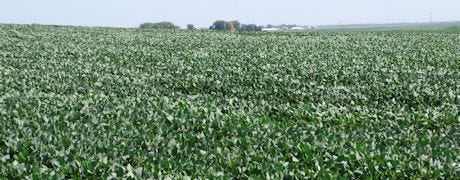
The time to aerial seed cover crops into standing corn and soybeans is not very far away. This reminder comes from Brian Lang, Iowa State University Extension field agronomist at Decorah in northeast Iowa. He offers the following information and guidelines to help you plan for a successful aerial seeding.

SUCCESSFUL SEEDING: For aerial seeding a cover crop into standing soybeans, you want the cover crop seed on the ground before more than 10% of the leaf drop occurs. For corn, it's not as clear cut as to when it is best to aerial seed with which cover crops.
For soybeans, aerial seeding should be accomplished before the R6.5 stage of growth of the soybean plant. At R6.5 stage, soybeans start showing leaf yellowing in the lower half of the canopy, soon to be followed by some leaf drop. "We want the seed on the ground before more than 10% of the leaf drop occurs," says Lang. "It is usually about nine days from beginning R6 stage to R6.5 stage. This makes early R6 stage a good trigger to start aerial seeding into soybean fields." To refresh your memory of soybean staging, please click here.
For corn, it's not as clear cut as to when it is best to do what with which cover crops. The general idea is to wait until the corn canopy would be a week or two away from starting to "open up" and let sunlight in, he says. This suggests anywhere from just past ½ milk line to initial black layer stage. The overriding factor is most likely soil moisture, and not so much whether the corn plant is at ½ milk line or black layer stage. After initial black layer stage is reached, the corn plant canopy will start opening up allowing sunlight to penetrate to the germinating/emerging cover crop.
As far as what cover crops and seeding rates to use, the possible combinations are boundless. If this cover crop management is new to you, start simple, says Lang. The NRCS has a basic publication on cover crops with suggested seeding rates and seeding windows. For those farmers who are looking for more comprehensive information on cover crops, the "catch-all" website is the Midwest Cover Crops Council homepage.
~~~PAGE_BREAK_HERE~~~
Tolerance of fall cover crops to earlier applied herbicides
There is a long way to go looking at combinations of fall planted cover crops and their tolerance to spring applied herbicides, but for starters here is a recently published fact sheet that explains the tolerance of a few cover crops to some commonly used herbicides. In addition to this is a publication from Penn State that lists additional herbicides and cover crops, and their best guess professional opinion on what cover crop is tolerant of what herbicide.
If you are concerned about herbicides that you have applied and how they might impact your planned cover crop, the best thing to do is to complete a soil bioassay, says Lang. Collect the top inch or two of soil from the field where you want to plant cover crops. Put that soil in a disposable pan. Seed your cover crop of choice and water. Keep watch as to whether the seeds germinate, or whether they germinate, grow and then die. If they die, you may want to consider an alternative cover crop.
Green Cover Seed, a seed company from Nebraska, offers a free herbicide tolerance cover crop seed test packet. The packet contains eight different species. You simply sow the packet and observe for 10 to 14 days to determine if the crop will survive. Not all of those species are commonly used in Iowa, but they should give you an indication as to whether small-seeded crops like radish will survive. For more information on this go to the Green Cover Seed website (Neither endorsement of companies, individuals or their services mentioned is intended, nor is criticism implied of similar companies, individuals or their services not mentioned).
Feeding restrictions for cover crops
Whether or not you can feed cover crops depends on earlier used herbicides. Here is a publication from the University of Wisconsin that outlines many of the livestock feed restrictions on cover crops depending on type of cover crop and kind of herbicides used earlier in the season for the corn or soybean crops.
About the Author(s)
You May Also Like




